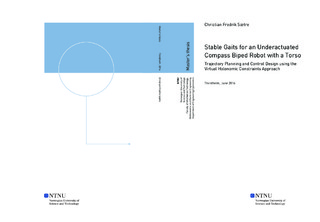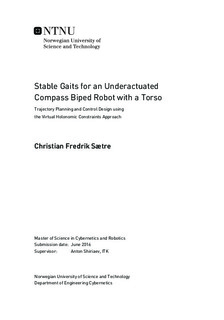| dc.description.abstract | The versatility of two-legged walking can make bipedal robots ideal for operations in rough terrain and environments designed for human beings. In order to make such robots able to operate over long periods of time and handle unexpected external disturbances, it is crucial that their gaits are energy efficient and stable with respect to perturbations from the nominal locomotion.
This thesis considers gait planing and the development of stabilizing controllers for a planar compass biped with a torso using the virtual holonomic constraints approach. The biped considered has three degrees of freedom and two actuators, and is thus underactuated by a degree of one. It is further considered as a hybrid dynamical system with a continuous phase and a discrete phase arising from the sudden change in velocities occurring from the impact of the swing leg with the ground at the end of a step.
Feasible gaits for the biped are found by assuming that a set of geometrical relations, called virtual holonomic constraints, between the configurations variables and a scalar variable, referred to as the motion generator, are kept invariant by feedback control. This constrains the evolution of the dynamical system to a two-dimensional submanifold of the state space, describing the evolution of the motion generator. For a given motion generator, virtual holonomic constraints which describes a feasible gait are then found by solving a non-linear optimization problem which minimizes a desired cost criteria. It is shown that highly energy efficient gaits with low torque requirements can be found with the method presented. Moreover, it is shown that the choice of the motion generator heavily influences which feasible gaits that can be found, and that obvious candidates for the motion generator, as the angle of the stance leg, can greatly restrict the search space.
Stabilizing controllers are developed by stabilizing a linear, time-varying system corresponding to the linearization of a set of transverse coordinates which are exactly zero on the nominal trajectory. Two different types of controllers based on transverse linearization are developed. The first uses the angle of the stance leg as the motion generator and five transverse coordinates, which is minimum number of independent transverse coordinates. The second method approximates the motion generator through a projection from the configuration variables of the biped, such that it can be used to stabilize gaits where the motion generator is not directly known as a function of the configuration. Transverse linearization is then carried out for six excessive transverse coordinates. For both methods, a stabilizing controller is then developed which exponentially stabilizes the linear time-varying system corresponding to the linearized transverse dynamics by solving the Riccati differential equation with one jump. This is done by transforming the Riccati differential equation to a linear matrix inequality and solving a semi-definite programming problem. The found controllers then renders the trajectory of the non-linear system locally, exponentially orbitally stable. It is shown in numerical simulations that both control methods can stabilize gaits with respect to small perturbations from the nominal motion and changes in the system parameters from those used in the development of the controllers. | |

